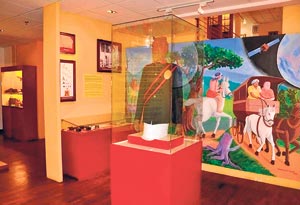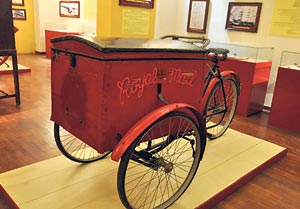Way back in 1850 – 160 years ago – a pigeon postal service was begun between Colombo and Galle. The exact date has been recorded as September 24.
Under this service, pigeons were used to send letters up and down. The service had continued for at least eight years. By that time mail between Colombo and Kandy was being sent through horse drawn
carriages. That service had started in 1831. The coach carried all the mail from post offices along the route.
 |
| Entrance to the museum |
 |
| Postmen in the early days |
 |
| Tricycle |
The Dutch started a postal service in 1798 but the service had been
confined to the Dutch East India Company.
The Postal Department was established in 1815, as a public service under the British. The first post offices were opened in Colombo, Galle, Matara, Mannar, Trincomalee and Jaffna.
With the expansion of the plantation industries from 1830 onwards, the postal service had to be widened. The number of post offices was increased and the service area also widened rapidly.
In the early days the delivery of mail was done using runners. It was risky for them to carry the mail bag and walk from place to place. So they carried a spear for their protection.
The newly established Postal Museum at D. R. Wijewardene Mawatha
in Colombo in the
headquarters office
building of the Postal Ministry takes you through an interesting
history of the postal
activities in the country
from the days of the British.
This has been done through photographs,
models and actual material used in post offices.
The red boxes set up alongside main roads where we drop our
letters (provided they are stamped) are a familiar sight throughout the
country. Although they look the same there are slight variations in them.
Each time a British
monarch changed, the emblem relating to the monarch on the post box was changed.
At the time the postal department was
established, Queen Victoria was the monarch ruling over the British Empire. She was followed
by Edward VII, George V
and George VI whose emblems appeared on the post boxes as and when they were crowned.
These are exhibited in the museum and visitors are able to get an idea of how they are set up as well. A good portion of the post box had been well secured in the ground so that no one could take them out
easily.
The postman is a
regular visitor to
anyone's house. In the old days he could be
easily identified since he wore a khaki uniform. In fact, the postman first wore a khaki coat and a white sarong. Later he used to wear a pair of shorts and a coat and wore a hat too – all in khaki. This uniform was changed to khaki longs and shirt. The postman then sported a cap.
The uniform is no more and today he is just another person coming on a push cycle to deliver letters. The change is well
illustrated through models in the museum.
The stamp on each letter is cancelled with a seal
indicating the date and place from where the letter has been posted. The sender of the letter has paid for the stamp which means the
government has already
collected the revenue.
 |
| Runner |
Once cancelled, the stamp cannot be used again.
A large variety of postmarks are among the museum exhibits. These include
postal seals, hand stamps and date stamps.
The mode of
communication between post offices has seen a vast revolution over the years.
The machines used during the pioneering era are
exhibited so that one can gain an insight into the progress made over two
centuries.
Various modes of
transport were used to
dispatch mail from one place to another. These included carts and tricycles which were used to transport mail bags between short
distances.
Today there are over 4,700 post offices throughout the country. These fall into three categories – main post offices (643), sub post offices (3411) and agency post
offices (684).
A visit to the museum gives an overall picture of how the postal services have been of immense service to the community. |





